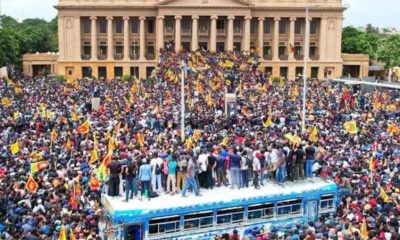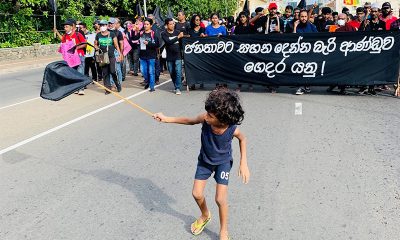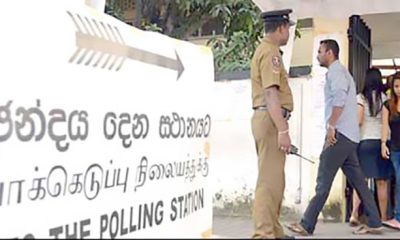Features
Review: ‘Footnotes of a Protest’ – A Response in Verse by Tennekoon, E M

By Ven. Siri Vajiraramaye Nanasiha
The book ‘Footnotes of a Protest’ – A Response in Verse by Tennekoon, EM was handed to me by a close associate, with a request to write a review, if possible. I declined at first, because I felt that it should be done by a person more competent than me. Nonetheless he insisted. True enough, English Literature was a subject I followed for my Senior School Certificate exam, and that was over seven decades ago. English usage has changed considerably since then.
I have not met the author, nor seen her even from a distance. The image I have of her is from her own introduction of herself as a ‘stubborn citizen’, who is knowledgeable and aware of her constitutional rights.
The contents are of the events that occurred in 2022; the memories of which are perhaps fading gradually except in the minds of a few. In the back cover the author writes: “Some days are best forgotten: and others worth remembering forever. 2022, was one such year and while the poetry that flows through these pages attempts to capture the emotions of living through upheaval; it is the time line of events stamped on the edge of each page that binds us to the realities we experienced.”
On this I fully agree with her. What has been penned in verse gets life and meaning only when viewed in that context. I read the book twice over, which I should say is very well presented with illustrations by Farah Fazly. First, I read the poetry with the time line of events as they happened, after which I read only the musings of the author that have been presented in verse. Both were enjoyable.
In the time line the author has recorded how ‘sporadic citizen-led protests’ in different places of the country gradually grew into the so-called aragalaya that brought persons of different age groups, social status and vocations to congregate in front of the Presidential Secretariat clamouring for a Systems Change. The daily occurrences in different fronts not only of those in the vanguard of the protest but also of government and international bodies like the IMF, and the political changes that were happening during the period: March 01 to September 04, 2022, have been reminisced succinctly by the author for which she has to be commended. Two examples of the timeline and the responses (indented) are given below as illustration.
1) 3rd April – Protests continue – sporadic and mostly small-scale. Largely urban and middleclass / Student-led protests in Peradeniya / All 26 Cabinet Ministers tender letters of resignation to the President / Social Media is blocked, then unlocked / Bandara granted bail, SM posts show many lawyers present in support.’
3. What we need:
Is for those already elected to grow a spine,
Appoint from among themselves the most suitable for each portfolio regardless of party,
Leaving out the lot we know has failed us time and again
And once appointed, act out of character and actually do their job!
4. What we don’t want or need:
Is for you to lie to us, shuffle the cabinet, have talks behind closed doors that go nowhere.
Promote your personal agenda by saying you are with us by not accepting posts so that you can appear good and, at the same time, get out of cleaning up the mess.
We ARE NOT Stupid! (Page 15)
2) As June Progresses
The severe shortage of LP Gas has resulted not only in long queues and agitations, but also in people actively seeking alternative methods ranging from wood stoves to electric ovens / Scarcity of electronics is seen as well as soaring prices / Also innovations to traditional stores.
‘Disaster seems to result in both widening disparity and strange equality’
Captive
Them cylinders:
Yellow. Blue.
Groups; tied; chained.
Guarded. Priceless.
Empty and useless;
Unwilling hostages
of a nation’s fate.’ (Page 37)
During the period March to September, there was much anxiety and uncertainty of what would happen next. With all the turbulence in the air, life too had to go along. Hence, at times, it is difficult to have a consequential time line. The author has overcome this by inserting interspaces between one series of events and the next.
The first such interspace in verse has the title ‘Exam Hall’ referring to the GCE (OL) Examination held in May, when children in spite of electricity outages, restricted transport due to the fuel crisis, closing of schools etc., were to sit their first public examination, which was of crucial importance to their future. There are nine interspaces in the book allowing the author space to philosophize. Some that caught my attention were: ‘Called’, ‘That Darned Document’ and ‘Civil Aspirations’. I felt that the interspaces were an ingenious method profitably used by the author to convey her almost sarcastic view of happenings around, which cannot be condoned.
It was Karl Marx, the German philosopher and political theorist, who said “History repeats itself, first as a tragedy, second as a farce’’. The happenings during the period of the protest have been a reminder of this oft quoted remark. I felt that the author has penned her thoughts in verse as a day or week passed. Some events have reminded the author of the apocalypse or total destruction; Medusa – a human female with living venomous snakes instead of hair in Greek mythology, and Hecate and Graymalkin (witch and cat) mentioned in Shakespeare’s plays. Subtle humour was encompassed with anger. In the context of July 13, 2022, referred to ‘as a day to be marked like no other’ the caption given to her thoughts was ‘Premature …. (Sinhala name for kiribath).
‘Kiribath ill befits a revolution
for anything fought for,
won or lost,
is no clear-cut celebration
nor a birthday for rejoicing
but a birthright/ to be nurtured,
guarded,/defended from marauders,
and kept alive no matter the challenge
for in the balance hangs
the survival of a nation.’ (Page 60)
One last quote:
Context: grinning MPs, theatrical protests, arrests and bail, debts not restructured and bailouts never happening.
Despair
A knife to my wrist
A dagger in my broken heart
The shards of hope lost
Cut deeper than shattered glass. (Page 55)
Time and space are inadequate to do adequate justice to this very commendable endeavour and I am fervently of the view that the book deserves greater recognition among literary circles.
Features
Kashmir terror attack underscores need for South Asian stability and amity

 The most urgent need for the South Asian region right now, in the wake of the cold-blooded killing by gunmen of nearly 30 local tourists in Indian-administered Kashmir two days back, is the initiation of measures that could ensure regional stability and peace. The state actors that matter most in this situation are India and Pakistan and it would be in the best interests of the region for both countries to stringently refrain from succumbing to knee-jerk reactions in the face of any perceived provocations arising from the bloodshed.
The most urgent need for the South Asian region right now, in the wake of the cold-blooded killing by gunmen of nearly 30 local tourists in Indian-administered Kashmir two days back, is the initiation of measures that could ensure regional stability and peace. The state actors that matter most in this situation are India and Pakistan and it would be in the best interests of the region for both countries to stringently refrain from succumbing to knee-jerk reactions in the face of any perceived provocations arising from the bloodshed.
The consequences for the countries concerned and the region could be grave if the terror incident leads to stepped-up friction and hostility between India and Pakistan. Some hardline elements in India, for instance, are on record in the international media as calling on the Indian state to initiate tough military action against Pakistan for the Kashmiri terror in question and a positive response to such urgings could even lead to a new India-Pakistan war.
Those wishing South Asia well are likely to advocate maximum restraint by both states and call for negotiations by them to avert any military stand-offs and conflicts that could prove counter-productive for all quarters concerned. This columnist lends his pen to such advocacy.
Right now in Sri Lanka, nationalistic elements in the country’s South in particular are splitting hairs over an MoU relating to security cooperation Sri Lanka has signed with India. Essentially, the main line of speculation among these sections is that Sri Lanka is coming under the suzerainty of India, so to speak, in the security sphere and would be under its dictates in the handling of its security interests. In the process, these nationalistic sections are giving fresh life to the deep-seated anti-India phobia among sections of the Sri Lankan public. The eventual result will be heightened, irrational hostility towards India among vulnerable, unenlightened Sri Lankans.
Nothing new will be said if the point is made that such irrational fears with respect to India are particularly marked among India’s smaller neighbouring states and their publics. Needless to say, collective fears of this kind only lead to perpetually strained relations between India and her neighbours, resulting in regional disunity, which, of course would not be in South Asia’s best interests.
SAARC is seen as ‘dead’ by some sections in South Asia and its present dysfunctional nature seems to give credence to this belief. Continued friction between India and Pakistan is seen as playing a major role in such inner paralysis and this is, no doubt, the main causative factor in SARRC’s current seeming ineffectiveness.
However, the widespread anti-India phobia referred to needs to be factored in as playing a role in SAARC’s lack of dynamism and ‘life’ as well. If democratic governments go some distance in exorcising such anti-Indianism from their people’s psyches, some progress could be made in restoring SAARC to ‘life’ and the latter could then play a constructive role in defusing India-Pakistan tensions.
It does not follow that if SAARC was ‘alive and well’, security related incidents of the kind that were witnessed in India-administered Kashmir recently would not occur. This is far from being the case, but if SAARC was fully operational, the states concerned would be in possession of the means and channels of resolving the issues that flow from such crises with greater amicability and mutual accommodation.
Accordingly, the South Asian Eight would be acting in their interests by seeking to restore SAARC back to ‘life’. An essential task in this process is the elimination of mutual fear and suspicion among the Eight and the states concerned need to do all that they could to eliminate any fixations and phobias that the countries have in relation to each other.
It does not follow from the foregoing that the SAARC Eight should not broad base their relations and pull back from fostering beneficial ties with extra-regional countries and groupings that have a bearing on their best interests. On the contrary, each SAARC country’s ties need to be wide-ranging and based on the principle that each such state would be a friend to all countries and an enemy of none as long as the latter are well-meaning.
The foregoing sharp focus on SAARC and its fortunes is necessitated by the consideration that the developmental issues in particular facing the region are best resolved by the region itself on the basis of its multiple material and intellectual resources. The grouping should not only be revived but a revisit should also be made to its past programs; particularly those which related to intra-regional conflict resolution. Thus, talking to each other under a new visionary commitment to SAARC collective wellbeing is crucially needed.
On the question of ties with India, it should be perceived by the latter’s smaller neighbours that there is no getting away from the need to foster increasingly closer relations with India, today a number one global power.
This should not amount to these smaller neighbours surrendering their rights and sovereignty to India. Far from it. On the contrary these smaller states should seek to craft mutually beneficial ties with India. It is a question of these small states following a truly Non-aligned foreign policy and using their best diplomatic and political skills to structure their ties with India in a way that would be mutually beneficial. It is up to these neighbours to cultivate the skills needed to meet these major challenges.
Going ahead, it will be in South Asia’s best interests to get SAARC back on its feet once again. If this aim is pursued with visionary zeal and if SAARC amity is sealed once and for all intra-regional friction and enmities could be put to rest. What smaller states should avoid scrupulously is the pitting of extra-regional powers against India and Pakistan in their squabbles with either of the latter. This practice has been pivotal in bringing strife and contention into South Asia and in dividing the region against itself.
Accordingly, the principal challenge facing South Asia is to be imbued once again with the SAARC spirit. The latter spirit’s healing powers need to be made real and enduring. Thus will we have a region truly united in brotherhood and peace.
Features
International schools …in action

 The British School in Colombo celebrated the 2025 Sinhala and Tamil New Year with the traditional rites and rituals and customs unique to the island nation, during a special Avurudu Assembly held at the school premises.
The British School in Colombo celebrated the 2025 Sinhala and Tamil New Year with the traditional rites and rituals and customs unique to the island nation, during a special Avurudu Assembly held at the school premises.
Students from all over the world, who are part of The British School in Colombo, gathered to celebrate this joyous event.
The special assembly featured traditional song and dance items from talented performers of both the Junior and Senior Schools.
On this particular day, the teachers and students were invited to attend school in Sri Lankan national costume and, among the traditional rituals celebrated, was the boiling of the milk and the tradition of Ganu-Denu.

Boiling of
the milk
In the meanwhile, a group of swimmers from Lyceum International School, Wattala, visited Australia to participate in the Global-ISE International Swimming Training Programme in Melbourne.
Over the course of 10 days, the swimmers followed an advanced training schedule and attended sessions at the Melbourne Sports and Aquatic Centre (MSAC), Victoria’s Nunawading Swimming Club, and Camberwell Grammar School.
In addition to their training, the group also explored Melbourne, with visits to key landmarks, such as the Parliament House and the Melbourne Cricket Ground (MCG), along with city tours and cultural experiences.

Traditional dance item

Tug-of-war contest

On arrival in Melbourne, Lyceum International School, Wattala, with Sri Lankan officials
Features
Perfect … and healthy

 Got a few more beauty tips to give you … for a perfect complexion, or, let’s say, a healthy skin.
Got a few more beauty tips to give you … for a perfect complexion, or, let’s say, a healthy skin.
* Honey Face Mask:
Take a tablespoon of raw honey and then warm it up by rubbing it with your fingertips. Apply the warm honey all over your face. Let this natural mask stand for about 10 minutes and then wash it off gently with warm water.
* Coconut Milk Face Mask:
You need to squeeze coconut milk out of a grated raw coconut and apply this milk all over your face, including your lips.
(This will help you gain a glowing skin. It is one of the best natural tips for skin care)
* Orange, Lemon, and Yoghurt Moisturiser:
To prepare this moisturiser, you need a tablespoon of orange juice, a tablespoon of lemon juice and a cup of plain yoghurt.
Mix them together and apply the paste all over your face, leaving it as a mask for 10 to 15 minutes. Next, take a damp handkerchief and use it to clean your face.
(This moisturiser brightens the complexion of your skin)
* Cucumber and Lemon:
Apply equal parts of cucumber and lemon juice on your face before taking a bath. Allow it to sit for 10 minutes before rinsing it off. This natural face beauty tip will brighten your skin tone and lighten blemishes if used on a regular basis. The best aspect is that it is appropriate for all skin types!
* Healthy Diet:
Aside from the effective home remedies, there are certain other factors to consider for skin care – and the first of them is your diet. Without the right nutrients, your skin cannot reverse the damage it suffers every day.
Eat fruits that are high in vitamin C because they contain antioxidants.
Adjust your diet to get the right amount of protein and unsaturated fats, as well as fresh green vegetables. All of this provides the right amount of nutrients so your skin can heal and improve itself naturally.
* Sun Protection and Care:
Another thing to keep in mind is not to step out of your home without sunscreen, especially with this awful heat we are experiencing at the moment. The hard rays of the sun can do you more damage than you could ever imagine.
By the way, you can prepare your own sunscreen lotion with glycerin, cucumber juice and rose water. You can also keep this lotion in the fridge.
-

 Business6 days ago
Business6 days agoDIMO pioneers major fleet expansion with Tata SIGNA Prime Movers for ILM
-

 News5 days ago
News5 days agoFamily discovers rare species thought to be extinct for over a century in home garden
-

 Features7 days ago
Features7 days agoProf. Lal Tennekoon: An illustrious but utterly unpretentious and much -loved academic
-

 Foreign News6 days ago
Foreign News6 days agoChina races robots against humans in Beijing half marathon
-

 Features3 days ago
Features3 days agoRuGoesWild: Taking science into the wild — and into the hearts of Sri Lankans
-

 Editorial6 days ago
Editorial6 days agoSelective use of PTA
-

 News3 days ago
News3 days agoOrders under the provisions of the Prevention of Corruptions Act No. 9 of 2023 for concurrence of parliament
-

 Features4 days ago
Features4 days agoNew species of Bronzeback snake, discovered in Sri Lanka
























